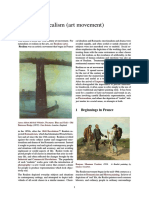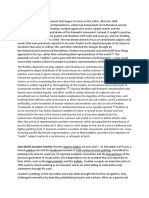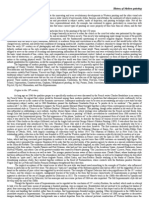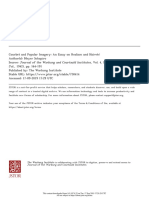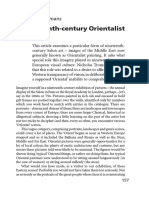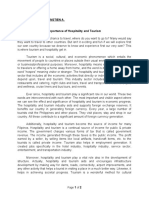Petra Chu - Courbet PDF
Petra Chu - Courbet PDF
Uploaded by
AlexandraCopyright:
Available Formats
Petra Chu - Courbet PDF
Petra Chu - Courbet PDF
Uploaded by
AlexandraOriginal Title
Copyright
Available Formats
Share this document
Did you find this document useful?
Is this content inappropriate?
Copyright:
Available Formats
Petra Chu - Courbet PDF
Petra Chu - Courbet PDF
Uploaded by
AlexandraCopyright:
Available Formats
1
The Purposeful Sightseer:
Courbet and Mid-Nineteenth-Century Tourism
Petra ten-Doesschate Chu
The exhibition Courbet and the Modern Landscape, organized by the J. Paul Getty Museum in 2006, was
the result of an interest on the part of its curators, Mary Morton and Charlotte Eyerman, in rethinking
Courbets landscape painting.1 Conceptually, the exhibition and its catalogue marked a return to an
essentially formalist approach to art history. Such a return was the more refreshing as it concerned
Gustave Courbet, an artist whose oeuvre, for more than three decades, had been the preferred object of
alternative approaches to art history, be they sociohistorical/Marxist, feminist, psychoanalytical, or
semiotic. The practitioners of these approaches focused primarily on Courbets figure paintings and
underplayed his landscapes. In so doing, they neglected one of the most striking aspects of Courbets
workthe artists daring and revolutionary facture.
Courbet and the Modern Landscape was stimulating because it invited the visitor to look at Courbet, once
again, as an artist whose work concerned what the French call faire, i.e., the physical application of paint
to the canvas. The exhibition helped us see his paintings as they were seen in the first half of the twentieth
century, when critics from Claude Roger-Marx in the 1920s to Clement Greenberg in the late 1940s were
seduced by Courbets innovative painting technique. The latter, in particular, saw it as the beginning of
Modernism in painting, anticipating the Impressionists and Czanne.2 In her catalogue essay, Eyerman
went further and argued that Courbets landscapes contained the germs of the action paintings of Jackson
Pollock and Willem de Kooning, and even some works of the contemporary German artist Gerhard
Richter.3
For all the richness and sensuality of their surfaces, however, one cannot ignore that Courbets landscape
paintings are objective and concrete representations of specific sites, in France as well as abroad. Many of
them, as we shall see, represent common nineteenth-century tourist attractions. To modern viewers
unfamiliar with these locales, the formal qualities of the paintings may well be more interesting than their
subjects. However, this was hardly the case for Courbet and the public for which his paintings were
intended. Who, one might ask, were those admirers and buyers of the artists landscape paintings? As far
as we know, they were well-to-do middle-class viewersindustrialists and rentiers, both in Paris and the
provinces, who enjoyed sightseeing and travel. On Sundays, they would hike to a nearby ruin or natural
wonder. In the summer months, they might take a coach to the shore, embark on a river cruise on the
Seine, the Rhine, or the Meuse, or take the train to visit the Franche-Comt or Auvergne.
Courbet, traditionally, has been characterized as the landscape painter par excellence of the FrancheComt region, from which he hailed. His early biographers, Jules Castagnary and Georges Riat, were
convinced that his youth in Ornans had left an indelible impression on the artist and had decisively
marked his art, and particularly his landscapes. Riat wrote that, when the young Courbet left Ornans for
Paris, he carried the impressions of his native landscape, already drawn and colored in his heart
(dessins et colors dans son coeur).4 Castagnary agreed, commenting that wherever he went, he
Chu
The Purposeful Sightseer: Courbet and Mid-Nineteenth-Century Tourism
Papers from the Symposium Looking at the Landscapes: Courbet and Modernism
Held at the J. Paul Getty Museum on March 18, 2006
2007 J. Paul Getty Trust
carried the image [of the Franche-Comt] with him Courbet did not understand that a painter would go
abroad to find his motifs. To a young man who came to show him a view of the Orient, he said, Dont you
have your own country, is that why you find yourself obliged to borrow someone elses to paint?5
This conventional image of Courbet as a painter rooted in his native soil is still popular today, and it has
caused us to downplay, if not ignore, the fact that the artist was an inveterate traveler and sightseer and
that many of his landscapes were painted outside the Franche-Comt or even outside France.
Furthermore, it has caused us to lose sight of the fact that many of the landscapes that Courbet painted in
the Franche-Comt depict the regions well-known nineteenth-century tourist sitessites that had
become attractions both to local sightseers and to visitors from other regions of France or even from
abroad.6
Courbets youth coincided with the appearance of the Voyages pittoresques et romantiques dans
lancienne France (Picturesque and Romantic Travels in Old France), a huge serial publishing project that
was initiated in 1820, one year after the artists birth, by Baron Isidore Taylor, with the help of the writer
Charles Nodier.7 Taylor sought to produce albums with engaging texts and prints that described and
depicted picturesque cultural and natural sites in the various regions of France. Published in installments,
the Voyages pittoresques were exceedingly popular from the 1820s through the 1840s. Their subscribers,
it seems, were mostly armchair travelers, who delighted in their virtual visits to sites that, at the time,
were still difficult to access. Though the publication continued until 1878, the albums, ironically, lost some
of their appeal as armchair travel gradually turned into real tourism, thanks to improvements in coach,
train, and steamboat transportation.
Many of the regions that were the subjects of the initial Voyages pittoresques albums became popular
among these early tourists. The very first album, devoted to Normandy, popularized the river cruise up
the Seine, which took travelers from Paris to Le Havre, via the old city of Rouen. Subsequent albums
devoted to the Franche-Comt (1825) and Auvergne (2 vols., 182933) led to increased tourist traffic to
those distant and previously little-visited regions of France.
Courbet himself took his earliest pleasure trip to Normandy in 1841. Many of the drawings he made
during that voyage show precisely the kind of scenery that abounds in the Voyages pittoresques
medieval buildings and monuments, picturesque streets, and dramatic landscape scenery. His drawing of
the Fontaine de la Croix de Pierre in Rouen may serve as an example (fig. 1). The careful rendering of
architectural and sculptural detail and the attempt at creating interesting chiaroscuro effects, especially
inside the arches, correspond to the characteristic features of the lithographic plates found in the Voyages
pittoresques of the 1840s, such as the illustration of the choir screen at the church in Folgot, in the
Brittany albums of 184546 (fig. 2). In 1842, Courbet traveled via Strasbourg and Baden-Baden to
Switzerland, which had been a tourist destination since the eighteenth century. On this trip he drew not
only many of the picturesque streets and buildings in Strasbourg, but also some of the great natural
wonders of Switzerland beloved by nineteenth-century tourists, such as the Staubbach Falls in the
Lauterbrunnen Valley (fig. 3). The Swiss sites had figured in British and French illustrated travel books
that preceded Taylor and Nodiers publication, such as Gabriel Lorys Pittoresque de lOberland Bernois,
published in Paris in 1822, and the anonymous Picturesque Tour through the Oberland in the Canton of
Berne, in Switzerland (London, 1823), which was directly based on Lorys publication (fig. 4).
Chu
The Purposeful Sightseer: Courbet and Mid-Nineteenth-Century Tourism
Papers from the Symposium Looking at the Landscapes: Courbet and Modernism
Held at the J. Paul Getty Museum on March 18, 2006
2007 J. Paul Getty Trust
Figure 1
Gustave Courbet (French, 18191877), Fontaine de la Croix de Pierre
in Rouen, 1841. Drawing in sketchbook. Paris, Muse du Louvre,
Dpartement des arts graphiques, RF 29334. Photo: Thierry Le Mage,
Runion des Muses Nationaux / Art Resource, New York.
Figure 2
The Choir Screen in the Church at Folgot. Lithograph. Illustration
from Les Voyages pittoresques et romantiques dans lancienne France,
Isidore-Justin-Sverin Taylor and Charles Nodier, vols. 45, Bretagne
(184546).
Chu
The Purposeful Sightseer: Courbet and Mid-Nineteenth-Century Tourism
Papers from the Symposium Looking at the Landscapes: Courbet and Modernism
Held at the J. Paul Getty Museum on March 18, 2006
2007 J. Paul Getty Trust
Figure 3
Courbet, Gustave. The Staubbach Falls. Muse du Louvre, RF9105.
Photo: Madeleine Coursaget, RMN / Art Resource, New York.
Figure 4
The Staubbach Falls. Colored engraving. Reproduction from
Picturesque Tour through the Oberland in the Canton of Berne, in
Switzerland (London, 1823), pl. 10. Photo: Digital version made
available by David S. Miall at http://www.arts.ualberta.ca/~dmiall/
Traveltexts/Oberland_p.htm.
Figure 5
Gustave Courbet, The Bridge of Ambrussum, 1857. Oil on canvas,
47.5 x 63 cm (18 3/4 x 24 7/8 in.). Montpellier, Muse Fabre, 892.4.1.
Photo: Frederic Jaulmes, Muse Fabre, Montpellier Agglomeration.
Chu
The Purposeful Sightseer: Courbet and Mid-Nineteenth-Century Tourism
Papers from the Symposium Looking at the Landscapes: Courbet and Modernism
Held at the J. Paul Getty Museum on March 18, 2006
2007 J. Paul Getty Trust
Courbets fascination with tourism lasted his entire life. The artist traveled throughout France as well as to
Holland, Belgium, Germany, and Switzerland. Though he no longer carried a sketchbook with him after
the 1840s (at least as far as we know), he did paint pictures of well-loved tourist sites, knowing that they
would appeal to middle-class viewers and buyers. As he went to visit the Montpellier collector Alfred
Bruyas in 1857, for example, he painted the ruins of the Pont dAmbroix, or the Bridge of Ambrussum
(fig. 5), a popular nineteenth-century tourist attraction. Located near Lunel, between Montpellier and
Nmes, this ancient Roman bridge across the Vidourle River had once formed part of the famous Via
Domitia, the first highway built in Gallia (Gaul), which dated from the beginning of the second century
A.D. Originally the bridge had eleven arches, nine of which were destroyed in a series of floods of the
Vidourle; in Courbets time, only two were left.8 Courbets The Meeting (Bonjour, Monsieur Courbet) of
1854 (Muse Fabre) may well represent him on his way to, or returning from, Lunel, carrying on his back
the type of portable equipment that had been developed for the purpose of sketching landscapes and
cultural sites in situ.
Figure 6
Gustave Courbet, Bayard Rock, Dinant (Belgium), 1858. Oil on
canvas, 55 x 45.8 cm (21 3/4 x 18 in.). Cambridge, England,
Fitzwilliam Museum, 2386. Reproduction by permission of the Syndics
of the Fitzwilliam Museum, Cambridge.
In Belgium, in 1858, Courbet painted the famous Bayard Rock (Roche Bayard) in Dinant (fig. 6). En route
from Brussels to Frankfurt, where he spent the winter of 185859, he must have stopped in Dinant, a
town popular among tourists. It had both a railroad station and a dock for river steamboats, which ran
cruises on the Meuse River along dramatic rock formations such as the Freyr Rock, which Courbet
painted as well, though probably on a different occasion.9 The Bayard Rock was a particularly well-known
attraction of Dinant: not only was it spectacular, but it also had both legendary and historical associations.
Here the famous Bayard horse was said to have taken a giant leap across the Meuse, carrying the four sons
of Aymon to safety from the pursuit of Charlemagne. The horse pushed off with such force that the rock
split in two. The reality was considerably more prosaic: the rock had been divided by an explosion set off
by Louis XIVs army in order to create an exit route for the troops after they had taken the city of Dinant
in 1675.10
Chu
The Purposeful Sightseer: Courbet and Mid-Nineteenth-Century Tourism
Papers from the Symposium Looking at the Landscapes: Courbet and Modernism
Held at the J. Paul Getty Museum on March 18, 2006
2007 J. Paul Getty Trust
As the identities of the first owners of Bayard Rock and The Meuse River at Freyr are unknown, it is
impossible to determine whether, indeed, they bought these paintings because they had visited the sites
and were eager to possess the works as souvenirs of their trips. By contrast, it is almost certain that many
of the paintings of well-known Swiss sites that Courbet executed in the 1870s were made for the tourist
market. His numerous views of the Chteau de Chillon, some doubtlessly authentic (fig. 7), others
possibly painted by or with the help of assistants, echo the countless prints, book illustrations (fig. 8), and
postcards that were produced throughout the nineteenth century for those who came to see the site of
Lord Byrons famous novel, The Prisoner of Chillon (1819).11 Courbet also painted other tourist attractions
Figure 7
Gustave Courbet, Chteau de Chillon, 1874. Oil on canvas,
86 x 100 cm (33 7/8 x 39 3/8 in.). Ornans, Muse Gustave Courbet.
Photo: Erich Lessing, Art Resource, New York.
Figure 8
The Chteau de Chillon. Steel engraving. Illustration from vol. 2 of
William Beatty, Switzerland Illustrated in a Series of Views Taken
Expressly for This Work by W. H. Bartlett, Esq. (London, 1836).
Chu
The Purposeful Sightseer: Courbet and Mid-Nineteenth-Century Tourism
Papers from the Symposium Looking at the Landscapes: Courbet and Modernism
Held at the J. Paul Getty Museum on March 18, 2006
2007 J. Paul Getty Trust
Figure 9
Gustave Courbet, Grotto of the Giants (Grotte des Gants) near
Saillon, Switzerland, 1873. Oil on canvas, 87 x 93 cm (34 1/4 x
36 3/4 in.). Amiens, Muse de Picardie.
in Switzerland, such as Lake Geneva, Mont Blanc, and the Grotte des Gants (Grotto of the Giants), near
Saillon (fig. 9), which, though neglected by travelers today, was much visited in Courbets time by tourists
intrigued by the anthropomorphic shape of the rock. The herbalist F.-O. Wolf, who met Courbet in Saillon
in 1873, described the rock as follows:
The Salence flows here through a deep gorge, which certainly merits a visit, especially now
that its access is facilitated by a new road with suspended walkways and bridges. While this
gorge, formed by the incessant labor of the water, cannot rival those of Trient and Durnand,
it does nevertheless present some quite interesting particularities, if only the grotesque
head of a giant, a unique spectacle in its genre.12
Courbets painting corresponds in detail to Wolfs description, showing not only the grotesque head,
washed by numerous rivulets of water, but also the new walkways and bridges that offered access to the
rock. In this painting, exceptionally, Courbet has even added some tourists, including a lady with a
parasol and a hiker who, standing proudly on the giants head, reminds us vaguely of Courbets own selfimage as a tourist in the Montpellier region.
While it seems obvious that Courbets Swiss paintings were geared to the tourist market, many of his
Franche-Comt landscapes also may have been intended for a public of sightseers interested in the region,
which, like Normandy, had been among the first to be featured in the Voyages pittoresques (1825). Take,
Chu
The Purposeful Sightseer: Courbet and Mid-Nineteenth-Century Tourism
Papers from the Symposium Looking at the Landscapes: Courbet and Modernism
Held at the J. Paul Getty Museum on March 18, 2006
2007 J. Paul Getty Trust
Figure 10
Gustave Courbet, The Source of the Loue River, 1863. Oil on canvas,
84 x 106.5 cm (33 1/8 x 42 in.). Zurich, Kunsthaus. Photo: 2007
Kunsthaus Zurich. All rights reserved.
for example, The Source of the Loue River (fig. 10), one of Courbets many paintings of cave entrances and
sourcesa term that in the Franche-Comt refers not only to the origin of a stream or river, but also to
the place where a river that has gone underground reemerges. Standing in front of this painting, twentyfirst-century viewers are easily drawn to the works surface aspectsthe black, smoothly painted center
and the lighter periphery, sculpted in broad touches of white, black, brown, and gray with the palette
knife. It is tempting, today, to think of a painting like this in terms of twentieth-century non-objective
painting, as Eyerman has shown.13 But in so doing, it is all too easy to forget that the source of the Loue
was a major tourist attraction in Courbets time (and still is in our own), as were other cave openings, such
as the source of the Lison River and the Sarrazine Grotto, both of which were painted by Courbet. In a
drawing in one of his sketchbooks, dating from the early 1840s (fig. 11), we see a group of hikers, both
male and female, resting on the rocks inside a cavea clear indication of the popularity of these geological
wonders in the artists own time.
Figure 11
Gustave Courbet, Group of Tourists Seated at the Entrance to a Cave,
early 1840s. Drawing in sketchbook. Paris, Muse du Louvre, Dpartement des arts graphiques, RF 9105, fol. 24 verso. Photo: RMN / Art
Resource, New York.
Chu
The Purposeful Sightseer: Courbet and Mid-Nineteenth-Century Tourism
Papers from the Symposium Looking at the Landscapes: Courbet and Modernism
Held at the J. Paul Getty Museum on March 18, 2006
2007 J. Paul Getty Trust
Indeed, the caves and sources of the Franche-Comt were the foremost tourist attractions of the region
and had been a magnet for travelers since the eighteenth century. One of the most famous among them
was the Osselle (or Esselles) Cave. Known as early as the thirteenth century and regularly visited since the
sixteenth, this cave had become especially famous after its exploration by Georges Cuvier in the early
1820s, and after the discovery by William Buckland, in 1826, of the complete skeleton of a cave bear,
which was exhibited in the British Museum.14 Sometime before or in 1825, Baron Taylor visited the cave
to make a series of drawings that would be lithographed for the Franche-Comt volume of the Voyages
pittoresques (fig. 12).15
Figure 12
Isidore-Justin-Sverin Taylor (French, 17891879). Osselle Cave
(Grottes dEsselles), 1829. Pencil drawing with brown ink wash on
beige paper. Paris, Bibliothque Nationale. Lithographed for Les
Voyages pittoresques, vol. 3, Franche-Comt (1825).
Figure 13
Gustave Courbet, Dame Verte. Drawing in sketchbook. Paris, Muse du
Louvre, Dpartement des arts graphiques, RF29234, 17. Photo:
Thierry Le Mage, RMN / Art Resource, New York.
Chu
The Purposeful Sightseer: Courbet and Mid-Nineteenth-Century Tourism
Papers from the Symposium Looking at the Landscapes: Courbet and Modernism
Held at the J. Paul Getty Museum on March 18, 2006
2007 J. Paul Getty Trust
10
Nineteenth-century visitors were attracted to the caves and sources in the Franche-Comt not merely as
geological wonders but also for the legends that had attached themselves to these locations, as with the
Bayard Rock. One such legend concerned the Dame Verte, or Green Lady, a beautiful fairy who wandered
around the mountains and the fields in the summer but retired to the caves in the winter.16 An early
drawing of a cave by Courbet has the words Dame Verte written on the side (fig. 13). Another tale was
that of the Source Bleue, the place where the Cusancin brook emerges from the rocks, which was painted
by Courbet in 1872 (Stockholm, Nationalmuseum). This source, according to legend, owed its blue color to
the tears of Berthe, the unfaithful wife of Crusader Amaury de Joux. Locked up in prison for her affair, she
could see through a small window the gallows from which her lover was hanged.17
Though geological sites were the major tourist attractions of the Franche-Comt, they were not the only
ones. The region had a rich history that went back to Gallo-Roman times, and it boasted a number of
important historic buildings and sites. Here, in the first century BC, the Gallic tribe of the Sequani had
joined the Arverni, under Vercingetorix, in their revolt against the Romans. There was a huge debate, in
the middle of the nineteenth century, as to whether the ancient town of Alesia, where Julius Cesar had
defeated Vercingetorix, had become the village of Alaise, in the Franche-Comt, or Alise-la-Reine, a
village in the Cte dOr region. Much has been written, in this context, about Courbets Oak at Flagey
(fig. 14), a painting of a giant oak tree that local imagination must have associated with the ancient druids,
Figure 14
Gustave Courbet, The Oak at Flagey, or The Oak of Vercingetorix,
1864. Oil on canvas, 89 x 110 cm (35 1/8 x 43 3/8 in.). Tokyo,
Murauchi Art Museum.
the priest class of the Gauls.18 The paintings subtitleOak of Vercingetorix, Caesars Camp near Alesia,
Franche-Comtmoreover suggests that the tree had a place in the famous debate about the modern-day
location of Alesia.19 Ancient trees were favorite tourist destinations in the nineteenth century, when they
were admired both as biological marvels and for their historic associations. Courbet himself, in the early
Chu
The Purposeful Sightseer: Courbet and Mid-Nineteenth-Century Tourism
Papers from the Symposium Looking at the Landscapes: Courbet and Modernism
Held at the J. Paul Getty Museum on March 18, 2006
2007 J. Paul Getty Trust
11
Figure 15
Gustave Courbet, Hikers Resting under Trees, early 1840s. Drawing
in sketchbook. Paris, Muse du Louvre, Dpartement des arts
graphiques, RF 9105. Photo: Thierry Le Mage, RMN / Art Resource,
New York.
sketchbook mentioned above, had drawn just such an old tree (fig. 15), a destination of Sunday hikers who
contemplated the venerable old oak as their kids climbed its branches. It is tempting to see, in the figures
on the left, two young artists who are sketching the tree.
Figure 16
Gustave Courbet, Fort de Joux (detail), 1864. Oil on canvas,
73 x 60 cm (28 3/4 x 23 5/8 in.). Current whereabouts unknown.
Photo: Author.
The Fort de Joux (fig. 16) represents another type of cultural tourist attraction. The fort, which dominates
the Doubs Valley, dates back to the Middle Ages but became particularly notorious in the late eighteenth
and nineteenth centuries, when it served as a state prison. The comte de Mirabeau had been locked up
Chu
The Purposeful Sightseer: Courbet and Mid-Nineteenth-Century Tourism
Papers from the Symposium Looking at the Landscapes: Courbet and Modernism
Held at the J. Paul Getty Museum on March 18, 2006
2007 J. Paul Getty Trust
12
here in 1775; in the early nineteenth century, Napoleon had sent Franois-Dominique ToussaintLouverture, the leader of the Haitian independence movement, to the Fort de Joux, where he died from
tuberculosis contracted in his cold and airless cell.20
The examples discussed above seem to demonstrate that the subjects of Courbets landscapes were
important to the artist and to his public. Many of the sites he chose to paint were well-known tourist
attractions that were described in guidebooks, as well as depicted in prints and photographs and, by the
end of the century, even on postcards. Does that mean that Courbet was merely a belated imitator of the
Romantic tradition of the Voyages pittoresques? I would argue that he developed a new kind of touristsite picture that was deliberately different from the picturesque imagery that he had admired in his youth.
The prints in the Voyages pittoresques, and the paintings and watercolors related to them, had been
geared to armchair travelers, who loved amazing detail and amusing staffage. Courbets own work, I
venture, was destined for a public that had actually traveled to the places he painted and had experienced
the sites themselves, with all five senses. In other words, Courbet intended to produce paintings that
evoked that physical encounter.
Figure 17
Barend Cornelis Koekkoek (Dutch, 18031862), La Roche Bayard,
1835. River landscape of the Maas with La Roche Bayard (close to
Dinant). Pencil, pen and brown ink, brush and watercolor on paper,
24.2 x 32.9 cm (9 1/2 x 13 in.). Teylers Museum, Haarlem, AA 51.
Lets look once more at Bayard Rock (see fig. 6). In an earlier publication, I have compared this picture
with a drawing by the Dutch Romantic artist Barend Cornelis Koekkoek (fig. 17).21 At that time, I pointed
to the difference between Courbets scientific approach to the subject and Koekkoeks allegorical vision.
Today, I want to concentrate on the representational differences between the two works. In the drawing,
the huge size of the rock is emphasized by the tiny figures at its bottom, reminding us that there is often
something of the sublime in the picturesque. In the drawing of the rock itself, there is an excessive
emphasis on the irregular contour and on the strong contrast between light and shade that is created by
the clearly articulated facets of the rock. Those features, combined with the low viewpoint and the
Chu
The Purposeful Sightseer: Courbet and Mid-Nineteenth-Century Tourism
Papers from the Symposium Looking at the Landscapes: Courbet and Modernism
Held at the J. Paul Getty Museum on March 18, 2006
2007 J. Paul Getty Trust
13
medium of the work, make Koekkoeks image a textbook example of the picturesque tradition. Courbets
painting represents the antithesis to this tradition. His contours roughly block out the rock, which seems
almost streamlined in comparison to Koekkoeks drawing. Gone is the faceted surface of the rock, with its
strong contrasts between light and dark. Instead, it appears as a dark monolith silhouetted against the
sky. Rather than presenting an intensified, visual experience of the rock by overemphasizing irregularity
of contour and variation of texture and of light and shade, Courbet seems to have wanted to suggest
something about its tactility by simulating its roughness with the bumpy paint surface, heavily laid on
with both brush and palette knife. His view of the rock would have appealed to the travelers who had
visited the place in personwho had walked through the narrow path between the cliffs, perhaps touching
its sides with their hands. It is interesting to note how much more closely Courbets painting resembles
turn-of-the-century postcards, such as the one reproduced below (fig. 18), than it does Koekkoeks
drawing, in spite of the fact that there is a greater time lag between them. The postcard not only shows a
very similar viewpoint butthrough its photographic process (perhaps albumen)also offers a strong
sense of kinetic tactility.
Figure 18
Bayard Rock, Dinant. Postcard, late nineteenth century[?].
Source: Author.
Courbets paintings, then, represent a new way of looking at landscape that is quite different from the
Romantic picturesque tradition of his youth. Instead of engaging with the landscape in a purely visual
manner, Courbet tries to convey in his painting something of the total sensual reality of the landscape.
This includes, most importantly, engaging the viewers tactile sense; on occasion, his paintings may even
Chu
The Purposeful Sightseer: Courbet and Mid-Nineteenth-Century Tourism
Papers from the Symposium Looking at the Landscapes: Courbet and Modernism
Held at the J. Paul Getty Museum on March 18, 2006
2007 J. Paul Getty Trust
14
invoke a sense of smell or sound. Courbets seascapes, such as the one reproduced below (fig. 19), may
serve as an example of the latter. Unlike his Franche-Comt landscapes, they are thinly brushed and
convey a sense of lightness and freshness, which not only suggests the feeling of a soft sea breeze but, to
the particularly sensitive observer, perhaps even hints of the smell of the sea. By the same token, his wave
paintings (e.g., fig. 20), with their close-up viewpoints and agitated brushwork, suggest the roar of
the surf.
Figure 19
Gustave Courbet, LImmensit, 1869. Oil on canvas, 60 x 82.2 cm
(23 5/8 x 32 3/8 in.). London, Victoria and Albert Museum. Photo: Art
Resource, New York.
Figure 20
Gustave Courbet, The Wave, ca. 1871. Oil on canvas,
46 x 55 cm (18 1/8 x 21 3/4 in.). Edinburgh, National Gallery of
Scotland, NG 2233.
Chu
The Purposeful Sightseer: Courbet and Mid-Nineteenth-Century Tourism
Papers from the Symposium Looking at the Landscapes: Courbet and Modernism
Held at the J. Paul Getty Museum on March 18, 2006
2007 J. Paul Getty Trust
15
The mature Courbets anti-picturesque attitude was well-known in his time. In an 1860 essay, Jules
Champfleury wrote that Courbet was the artist who tackles the thing itself, and removes every element of
a false picturesque.22 Indeed, by the 1850s Courbet had turned away completely from the picturesque
leanings of his youth, disliking all its trappings of carefully selected sites (ruins and rustic cottages) and
viewpoints. Talking to the painter Chrubino Pata at the end of his life, Courbet recalled an episode that
took place in Normandy, probably in the 1860s. Walking along the sea in the evening with the poet
Charles Baudelaire, Courbet was taken by the latter to an opening between two rocks through which there
was a dramatic view of the sea. Courbet commented to Pata, Was he ever bourgeois! What are
viewpoints? Do viewpoints exist?23
Courbets landscape paintings were unique in the nineteenth century, and their distinctiveness was
related to the way in which Courbet engaged with the picturesque tradition. While other landscape
painters of his time, most notably the artists of the Barbizon school, turned their back on picturesque
subject matterpreferring instead the simple country and woodland scenes that could be found in the
environs of ParisCourbet continued to be interested in many of the subjects that had been popularized
by the Voyages pittoresques and similar Romantic travel publications. By treating them in a new way,
however, downplaying their visual aspects and emphasizing their tactility, he gave the viewer a more
comprehensive sensual appreciation of the subjects physical qualities. This aspect of Courbets
landscapes, as I have suggested in this article, may have appealed in particular to the well-to-do middle
class tourists who visited the sites depicted in his works.
Mary Morton and Charlotte Eyerman, eds., Courbet and the Modern Landscape, exh. cat. (Los Angeles: The J. Paul Getty Museum,
2006), p. 21.
1
For Greenbergs view of Courbet, see Charlotte Eyerman, Courbets Legacy in the Twentieth Century, Courbet and the Modern
Landscape (see note 1), pp. 2122.
2
Ibid., pp. 2334.
Georges Riat, Gustave Courbet, peintre (Paris, 1906), p. 22.
O quil allt, il en emportait limage avec lui Courbet ne comprenait pas quun peintre allt chercher des motifs ltranger. Un
jour quun jeune homme lui apportait juger une vue dOrient: Vous navez donc pas de pays, dit il, que vous soyez oblig
dempunter le pays des autres pour le peindre? (Unless otherwise indicated, translations by author.) Cited in Pierre Courthion,
Courbet racont par lui-mme et par ses amis, 2 vols. (Geneva, 194850), vol. 1, pp. 17071.
5
Due to its relative proximity to Switzerland and Germany, one would expect tourists from those countries to visit the FrancheComt, and they did. But apparently, the region was popular among British travelers as well. Xavier Marmier writes about ces fades
Anglais qui [y] courent en chaise de poste, un lorgnon dune main, un carnet de lautre (those insipid Englishmen, who travel
[there] by post coach, a lorgnette in one hand and a notebook in the other). See Souvenirs de voyages et traditions populaires
(Paris, 1841), p. 67.
6
Following, in alphabetical order, are the volumes of the Voyages pittoresques: Ancienne Normandie, 3 vols.: 1820, 1825, 1878;
Auvergne, 2 vols.: 182933; Bourgogne, 2 vols. (one text, one plates): 1863; Bretagne, 2 vols.: 184546; Champagne: 4 vols. (one
text, three plates): 1857; Dauphin, 2 vols. (one text, one plates): 1854; Franche-Comt, 1 vol.: 1825; Languedoc, 4 vols.: 183337;
Picardie, 3 vols.: 183545.
Chu
The Purposeful Sightseer: Courbet and Mid-Nineteenth-Century Tourism
Papers from the Symposium Looking at the Landscapes: Courbet and Modernism
Held at the J. Paul Getty Museum on March 18, 2006
2007 J. Paul Getty Trust
16
One of these was washed away by another flood in 1930, so that today only a single arch is left.
The painting, La Meuse Freyr (The Meuse River at Freyr, ca. 1856) is in the Muse des Beaux-Arts in Lille, France.
See Wandelingen door Belgi, De Aarde en haar Volken 22 (1886), cited in Project Gutenberg, EText 17082
(http://www.gutenberg.org/etext/17082), p. 315.
10
Sorting out which views of Chillon Castle are authentic is a difficult task. Robert Fernier, in his catalogue raisonn of Courbets
paintings, La Vie et loeuvre de Gustave Courbet, 2 vols. (Geneva and Lausanne, 197778), lists twenty-one views, but the
attribution of several of these is currently in doubt.
11
La Salence coule ici dans une profonde gorge qui mrite certainement une visite, surtout maintenant que labord en est facilit par
un nouveau chemin avec galeries et ponts. Cette gorge creuse par le travail incessant des eaux ne peut, il est vrai, rivaliser avec
celles du Trient et du Durnand, mais elle prsente cependant bien des particularits intressantes, ne ft-ce que la grotesque tte de
gant qui forme un spectacle unique en son genre. F.-O. Wolf, Les Environs de Saillon et ses carrires de marbre, Bulletin des
travaux de la Socit muritienne du Valais (1879). Cited in Lisbeth Koutchoumoff, Tableau de Courbet: Mystre lev Saillon, Le
Temps (Lausanne), July 19, 2002. I thank Dario Gamboni for drawing my attention to this newspaper article.
12
13
Eyerman 2006 (see note 2). Klaus Herding and Dominique de Font-Raulx make similar points in their papers in this volume.
14
See http://grottes.osselle.free.fr (accessed December 30, 2006).
Two of these drawings, including the one reproduced in figure 12, are in the Bibliothque Nationale in Paris. (On-line
reproductions, with captions, at http://gallica.bnf.fr/ark:/12148/btv1b77431889.notice and http://gallica.bnf.fr/ark:/12148/
btv1b77431889.notice.) Both drawings bear inscriptions that date them in 1829. However, the inscriptions appear to have been
added later, perhaps by someone unfamiliar with the date of Taylors visit. The inscriptions also ascribe the two drawings to different
authorsone to Taylor, the other to Charlet. There appears to be little doubt, however, that both drawings were executed by the
same artist, most likely Taylor.
15
16
See Marmier 1841 (see note 6), pp. 7678.
17
This story, in one form or another, is found in almost every tour guide of the region.
See, among others, Linda Nochlin, Le chne de Flagey de Courbet: Un motif de paysage et sa signification, Quarantehuit/Quatorze (Confrences du Muse dOrsay) 1 (1989): pp. 1525, and Petra ten-Doesschate Chu, It Took Millions of Years to
Compose That Picture, in Courbet Reconsidered, exh. cat., ed. Sarah Faunce and Linda Nochlin (New York, The Brooklyn Museum,
1988), pp. 58 and 230, notes 18 and 23.
18
19
On this debate, see J. Bruley, LIdentification de la vraie Alsia (Paris, n.d.).
20
On Toussaint-Louverture, see the Web site http://thelouvertureproject.org, which has full information and several online sources.
21
Chu 1988 (see note 18), pp. 6163.
Lartiste qui sattaque la chose en elle-mme, carte tout lment dun faux pittoresque. Champfleury, Grandes figures dhier
et daujourdhui (Paris, 1861), cited in Genevive and Jean Lacambre, eds., Champfleury, Le Ralisme (Paris, 1973), p. 186.
22
Etait-il assez bourgeois, hein! Quest-ce que cest que des points de vue? Est-ce quil existe des points de vue? Courthion 1948
50 (see note 5), vol. 1, pp. 15960.
23
Chu
The Purposeful Sightseer: Courbet and Mid-Nineteenth-Century Tourism
Papers from the Symposium Looking at the Landscapes: Courbet and Modernism
Held at the J. Paul Getty Museum on March 18, 2006
2007 J. Paul Getty Trust
You might also like
- Consolidated List of AMO Exam Passers For Calendar 2019 - 31 December 2019Document141 pagesConsolidated List of AMO Exam Passers For Calendar 2019 - 31 December 2019Jun Ortiz100% (1)
- Realism (Art Movement)Document7 pagesRealism (Art Movement)Marios Darviras100% (1)
- Monet Years at Giverny (Beyond Impresionism)Document190 pagesMonet Years at Giverny (Beyond Impresionism)Cuarto Oscuro100% (6)
- The Art of The Forger - Christopher Wright 1985Document168 pagesThe Art of The Forger - Christopher Wright 1985YnnodusNo ratings yet
- Courbet and The Modern Landscape - Expo Getty LADocument158 pagesCourbet and The Modern Landscape - Expo Getty LADanny100% (3)
- Delphi Complete Paintings of Gustave Courbet (Illustrated)From EverandDelphi Complete Paintings of Gustave Courbet (Illustrated)Rating: 4 out of 5 stars4/5 (1)
- Corot To Monet French Landscape PaintingDocument2 pagesCorot To Monet French Landscape PaintingDeltai KárolyNo ratings yet
- Japonisme and Bonnard's Invention of The Modern Poster: January 2008Document23 pagesJaponisme and Bonnard's Invention of The Modern Poster: January 2008João SpaccaNo ratings yet
- A Guide To Romanticism, Realism, and Expressionism in ArtDocument5 pagesA Guide To Romanticism, Realism, and Expressionism in ArtRowena Odhen UranzaNo ratings yet
- QCA Study Tour - Gabrielle MactaggartDocument39 pagesQCA Study Tour - Gabrielle MactaggartQCA GriffithNo ratings yet
- Gustave CourbetDocument26 pagesGustave CourbetsubirNo ratings yet
- LE CORBUSIER Impressions and DrawingsDocument12 pagesLE CORBUSIER Impressions and DrawingsophelieNo ratings yet
- Tourist PhotographyDocument6 pagesTourist PhotographyCi NaNo ratings yet
- Chagnan Burke_rue lafitteDocument25 pagesChagnan Burke_rue lafitteyagmurNo ratings yet
- Pierre Bonnard: The Graphic ArtDocument274 pagesPierre Bonnard: The Graphic ArtGizem Sozen92% (13)
- Magiciens de La Terre and The DevelopmeDocument70 pagesMagiciens de La Terre and The Developmelina de albuquerque LinaNo ratings yet
- Download full Landscape Painting in Revolutionary France Liberty s Embrace 1st Edition Steven Adams ebook all chaptersDocument85 pagesDownload full Landscape Painting in Revolutionary France Liberty s Embrace 1st Edition Steven Adams ebook all chaptersbishtspyke1l100% (6)
- Set Fashion StreetDocument32 pagesSet Fashion StreetFarhan Saeedy2No ratings yet
- Moderna UmetnostDocument66 pagesModerna UmetnostДрагиња ТубићNo ratings yet
- Realism Was An Artistic Movement That Began in France in The 1840s, After The 1848Document6 pagesRealism Was An Artistic Movement That Began in France in The 1840s, After The 1848Ellie Jane MapaNo ratings yet
- Gustave Courbet BIOGRAPHYDocument4 pagesGustave Courbet BIOGRAPHYsidchadmiNo ratings yet
- Unknown CorotDocument108 pagesUnknown CorotFrank Hobbs100% (5)
- Chapter EightDocument22 pagesChapter Eightszshah22No ratings yet
- Shah_ARTH 318 2nd examDocument7 pagesShah_ARTH 318 2nd examszshah22No ratings yet
- ART2005-SEM2-A-2122: Northern Renaissance Art: Friday 18 February Assignment Title: What Were The MainDocument7 pagesART2005-SEM2-A-2122: Northern Renaissance Art: Friday 18 February Assignment Title: What Were The Mainnaomi xuerebNo ratings yet
- Moderna UmetnostDocument26 pagesModerna UmetnostVesnap EsmaNo ratings yet
- Pierre-Auguste Renoir - La PromenadeDocument96 pagesPierre-Auguste Renoir - La Promenadelanci550% (2)
- Vision After The SermonDocument9 pagesVision After The SermonPatrick AlimuinNo ratings yet
- 2013 The 1912 Futurist Exhibition by Barbara Pezzini July 2013Document9 pages2013 The 1912 Futurist Exhibition by Barbara Pezzini July 2013Iván D. Marifil MartinezNo ratings yet
- Arts Research (Artists)Document25 pagesArts Research (Artists)Louis Gen FloresNo ratings yet
- Realism: Inovácia Obsahu A Metód Vzdelávania Prispôsobená Potrebám Vedomostnej SpoločnostiDocument12 pagesRealism: Inovácia Obsahu A Metód Vzdelávania Prispôsobená Potrebám Vedomostnej SpoločnostiJeremy MarcosNo ratings yet
- TTC - From Monet To Van Gogh, History of Impressionism (Brettell) - Guidebook 2Document32 pagesTTC - From Monet To Van Gogh, History of Impressionism (Brettell) - Guidebook 2ocelotepecariNo ratings yet
- Art + Travel Europe: Step into the Lives of Five Famous PaintersFrom EverandArt + Travel Europe: Step into the Lives of Five Famous PaintersNo ratings yet
- SCHAPIRO, M. Courbet and Popular Imagery - An Essay On Realism and NaïvetéDocument32 pagesSCHAPIRO, M. Courbet and Popular Imagery - An Essay On Realism and NaïvetéMatias Vilardaga EscorelNo ratings yet
- Domingo Arts Day 4-1Document63 pagesDomingo Arts Day 4-1jhonnellarosa.abadesaNo ratings yet
- Ingres in ReproductionDocument20 pagesIngres in ReproductionKarlNo ratings yet
- Alen Bowness - Manet (Ch. 01)Document7 pagesAlen Bowness - Manet (Ch. 01)KraftfeldNo ratings yet
- On CourbetDocument3 pagesOn CourbetShlomo Lee AbrahmovNo ratings yet
- FrenchDocument33 pagesFrenchPragati BansalNo ratings yet
- Delphi Complete Works of Édouard Manet (Illustrated)From EverandDelphi Complete Works of Édouard Manet (Illustrated)Rating: 5 out of 5 stars5/5 (1)
- The Magicians of Globalization. On Magiciens de La TerreDocument18 pagesThe Magicians of Globalization. On Magiciens de La Terreafrancaja100% (1)
- Nineteenth Century Orientalist PaintingDocument14 pagesNineteenth Century Orientalist PaintingAgung PirsadaNo ratings yet
- PDFDocument114 pagesPDFulisas77100% (4)
- British Highlights - MergedDocument11 pagesBritish Highlights - MergedGavelNo ratings yet
- Atget PresentationDocument50 pagesAtget PresentationJesica EcharriNo ratings yet
- Courbet Burial at Ornans Script PDFDocument4 pagesCourbet Burial at Ornans Script PDFnadiaNo ratings yet
- A Post Classical Landscape Greek PhotographyDocument7 pagesA Post Classical Landscape Greek Photographylyoga2024No ratings yet
- Praised and Ridiculed French Painting 18Document6 pagesPraised and Ridiculed French Painting 18endlessdaylight6863No ratings yet
- A Political and A Pictorial Tradition Used in Gustave Courbet's Real AllegoryDocument7 pagesA Political and A Pictorial Tradition Used in Gustave Courbet's Real AllegoryBruno AndradeNo ratings yet
- Turismo y Pintura en NormandíaDocument18 pagesTurismo y Pintura en Normandíaarmando adornoNo ratings yet
- Leonardo Da Vinci Experience ExperimentDocument2 pagesLeonardo Da Vinci Experience ExperimentJustin MawiNo ratings yet
- The Pen and the Brush: How Passion for Art Shaped Nineteenth-Century French NovelsFrom EverandThe Pen and the Brush: How Passion for Art Shaped Nineteenth-Century French NovelsNo ratings yet
- Meyer Schapiro - Courbet and Popular Imagery An Essay On Realism and NaïvetéDocument31 pagesMeyer Schapiro - Courbet and Popular Imagery An Essay On Realism and NaïvetéJean-Marc TangNo ratings yet
- Courbet Image M Popular 1941Document32 pagesCourbet Image M Popular 1941Daniela KernNo ratings yet
- Kita Draft PegununganDocument63 pagesKita Draft PegununganFathin SyifayaniNo ratings yet
- Capacidad de Carga para El Turismo LocalDocument10 pagesCapacidad de Carga para El Turismo LocalNikita PuertoNo ratings yet
- LatihanDocument9 pagesLatihanAngga TritamaNo ratings yet
- Hedonists Guide To WarsawDocument22 pagesHedonists Guide To Warsawapi-252322955No ratings yet
- Bihar TouristDocument5 pagesBihar TouristAditya SharmaNo ratings yet
- The Chocolate HillsDocument1 pageThe Chocolate HillsVeronChris Mison BalangatanNo ratings yet
- "A Four Star Hotel": March, 2022 Addis Ababa, EthiopiaDocument33 pages"A Four Star Hotel": March, 2022 Addis Ababa, EthiopiaTesfaye Degefa100% (1)
- EuroExam MINTAFELADAT - ReadingDocument1 pageEuroExam MINTAFELADAT - ReadingKiss GézaNo ratings yet
- Scott Resume Feb 2016Document1 pageScott Resume Feb 2016api-310440689No ratings yet
- Chapters 1-5Document174 pagesChapters 1-5Jovinal GonzalesNo ratings yet
- PasivDocument1 pagePasivBoban SimicNo ratings yet
- Caribbean GraphicDocument20 pagesCaribbean GraphicGTLIMENo ratings yet
- TA London GuideDocument8 pagesTA London GuideCAGMM100% (1)
- Hilton Case Study - FinalDocument28 pagesHilton Case Study - FinalAdam WicaksonoNo ratings yet
- Bulletin - 5th SEAKF (Final Ver)Document14 pagesBulletin - 5th SEAKF (Final Ver)Landmark Properti BanyuwangiNo ratings yet
- Week 3 Tourism and Hospitality Professional 3Document16 pagesWeek 3 Tourism and Hospitality Professional 3kimberly dueroNo ratings yet
- THETHIDocument3 pagesTHETHITea MetaNo ratings yet
- Atithi Devo Bhavah: Success or Failure in IndiaDocument19 pagesAtithi Devo Bhavah: Success or Failure in IndiaAmita AgrawalNo ratings yet
- English For Food and Drink StaffDocument11 pagesEnglish For Food and Drink StaffCarmen Peña GonzalezNo ratings yet
- Essay On Tourism and HospitalityDocument2 pagesEssay On Tourism and Hospitalityrmm0415No ratings yet
- English Speaking Board ESB Level 3 Certificate in ESOL International - All Modes (C2) 500/3655/5Document17 pagesEnglish Speaking Board ESB Level 3 Certificate in ESOL International - All Modes (C2) 500/3655/5Eleni KostopoulouNo ratings yet
- Major Project TourismDocument9 pagesMajor Project TourismJust WatchNo ratings yet
- Speaking QuestionsDocument3 pagesSpeaking QuestionsJesús Valentín Hernández HernándezNo ratings yet
- Organization and Management - Tourism ManagementDocument3 pagesOrganization and Management - Tourism ManagementManarangJanine100% (1)
- Beverage Service IndustryDocument2 pagesBeverage Service IndustryJeric SaLudoNo ratings yet
- SingerLCP Letter 9-29-15Document3 pagesSingerLCP Letter 9-29-15Coastal Hills Rural PreservationNo ratings yet
- BLK 6 Lot 3&5 Phase 2B Villa Trinitas Subdivision Bugo, Cagayan de Oro City 9000 Contact No: (+63) 9369604941Document5 pagesBLK 6 Lot 3&5 Phase 2B Villa Trinitas Subdivision Bugo, Cagayan de Oro City 9000 Contact No: (+63) 9369604941Ramon Chito S. PudelananNo ratings yet
- Unit 11 SpeakingDocument48 pagesUnit 11 SpeakingNhi NgNo ratings yet
- 01 - Muscats Many CitiesDocument47 pages01 - Muscats Many CitiesMurugan SridharNo ratings yet

